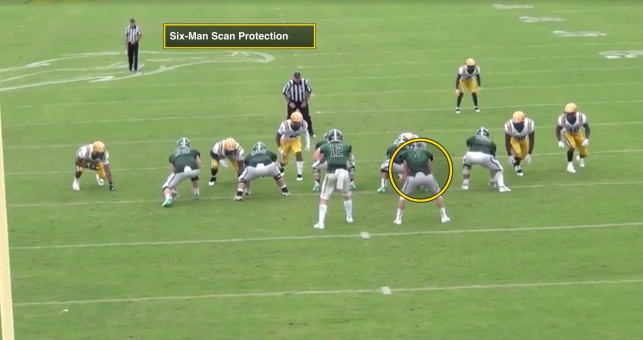By Grant Gower
Offensive Coordinator/QB Coach
Oklahoma Baptist University
Twitter: @OBUCoachGower
and Greg Gothard
Offensive Line Coach
Oklahoma Baptist University
Protecting the quarterback at all levels of football is of primary importance for any offense. Regardless of your style of offense, it is imperative to not allow sacks and give up negative yardage to the defense. At Oklahoma Baptist University, we are a spread, no-huddle, up-tempo offense that likes to attack all areas of the field. Within our throwing game, we have become very successful in passing offense and limiting the number of sacks allowed. In 2018, we had 506 passing attempts and only allowed 3 sacks in 11 games. In 2017, we had 423 passing attempts with only 9 sacks allowed, for a 2 year total of 929 attempts with 12 sacks, while completing 60% of our passes. This was coming off of 2016 where we allowed 22 sacks in 362 attempts. So how were we able to decrease the number of sacks while increasing our number of attempts dramatically? This report will explain some of those concepts and ingredients that have been beneficial for us.

Body/Coaching Points
To be able to be effective in any offense, it involves everyone to be on the same page and executing each play successfully. Obviously, the challenge that we all face is to be able to do that consistently day in day out and game in game out. Here are some of those key ingredients for our position groups:
- Offensive Line-Continuity/Consistency-all 5 must work together seamlessly regardless of who the personnel is on the field. In 2018, we had 3 senior offensive linemen that had played a lot of games together and were very experienced. Having that was a huge asset, but another key ingredient that we have utilized is rotating our OL guys in throughout practice and games. We travel 10 offensive linemen and it is important for all of them to know and understand each other and their assignments. We like to play at a very fast pace, and having a deep OL unit really enables us to work together and stay fresh as well.
- Tight Ends/H Backs-Pass Blocking or Receiving-our TE/H Back is a key ingredient not only from a blocking perspective, but also to be able to get out in routes. We will have our tight ends stay in at times for our 7 man protection, but also will release him into the route concepts as well. It is important for them to be strong enough to block a defensive end, and also agile enough to block a blitzing linebacker or defensive back.
- Running Backs-Pass Blocking or Receiving-our running backs not only are the main ball carriers but have an integral role in the passing game. One of those key ingredients is their pass blocking ability. Whether it is in a 6 man or a 7 man protection, he has to be able to pick up the rush or a stunt and "make us right". When he is on the route, it is important for him to be able to catch the ball and become a playmaker.
- Wide Receivers-Getting off of coverage-one of the major ingredients of not allowing sacks is for wide receivers to get open. Receivers must understand how the DB is playing him, whether that is in a zone look or in a press man coverage. The key is in varying releases off the ball to create the space necessary and beat the leverage that the defensive back is applying to the receiver.
- Quarterbacks-Pulls it all together-the main job of the quarterback is to keep everyone functioning as one unit. That entails many variables. His mobility and his ability to escape pressure if it does break down, recognizing coverages and where blitzes are coming from, and where his hot receivers are, all make for a quarterback that will be very effective. It is also important for him to know when and where to throw the ball away to avoid the sack.
For all of the moving parts to function effectively, there are several key ingredients. It starts by introducing the pass protection concept. We utilize a multitude of protections, and it is important for all the position groups to know and understand when and why we will use a certain protection scheme.
OL Pass Pro/Coaching Points
Bison Pass Protection Absolutes
- Knowing job/responsibility (Eyes)
- Trigger first
- Staying square/pad level
- Hands/Feet
First of all, we must know our job, who or what gap am I responsible for, and we must train our eyes to stay on our responsibility and not chase false reads. I must trigger or get my hand out of the grass first; if I start behind I will never catch up. It is imperative that we keep our hips square and our pad level down. By doing that, it allows us to maintain our leverage on our defender we are responsible for blocking. Keeping our hands and feet active throughout the play is key in keeping our defender off the QB. Our blitz pick up is no doubt the most important thing we do for pass protection, and we are able to work on these 4 Absolutes repeatedly at game speed.









